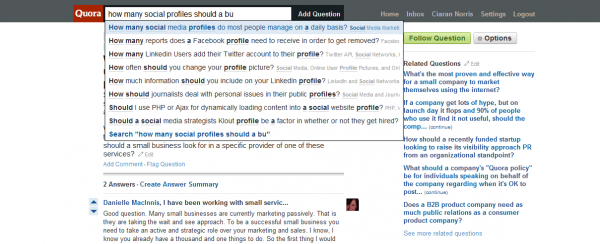Social Profiles: It’s Quality, Not Quantity
A couple of weeks ago, I spoke at the excellent SMX Sydney conference. As usual, it was a great show with any number of fantastic speakers. Before my last session, I was preceded by the also very excellent Rand Fishkin from SEOmoz; his presentation on Social Media For SEO was, as with most of his content, must-have […]
A couple of weeks ago, I spoke at the excellent SMX Sydney conference. As usual, it was a great show with any number of fantastic speakers. Before my last session, I was preceded by the also very excellent Rand Fishkin from SEOmoz; his presentation on Social Media For SEO was, as with most of his content, must-have info.
However, for once, I found myself disagreeing with Rand on at least one point.
Towards the end of his deck, Rand showed the names of 15 different social platforms and said that every brand or company should be using, at a minimum. He felt that it was essential that brands create, maintain and use all of these in order to maximise the likely benefit to SEO. But I have to say that I think he’s wrong on this one.
In my recent post on how to plan & implement social strategies, one of the areas I said you need to cover is your approach. This encompasses a number of different topics, but one of the most important ones is the area of resource. Put simply, if you start implementing social marketing for whatever reason, who will do what?
Because if you decide to jump into Facebook, or YouTube, or wherever, but haven’t planned for how you will manage and continue the conversations that this is likely to create (if your strategy works), then you may as well not even start, as all you’ll be doing is wasting time and money.
Furthermore, if you happen to be a multinational brand (as many of our clients are) then jumping headlong into multiple platforms is basically a recipe for disaster. Trying to manage multiple profiles on one platform is difficult enough as it is (again, I looked at this in a previous post). Trying to keep up as your various business units start setting up, and most likely abandon, profiles on different networks, would give even an organisational wizard a headache.
Just as an example, once a company has been set up on LinkedIn, it is almost impossible to change it; what if one of your enthusiastic employees happens to get the details wrong?
Whilst there are undoubtedly some platforms that require little management, such as Slideshare or Scribd, others most definitely do. Quora, which is this year’s hyped platform of choice, is seriously unlikely to generate any value without some serious love and attention.
In fact, it’s arguable what value, other than the fact that Quora questions are starting to appear in the rankings, it generates anyway. And maybe this is why Rand and I disagree. In this instance, he’s looking at how social platforms can help generate links, whereas, now that I’ve moved away from SEO, I’m really only concerned with how they can engage consumers, and drive overall business objectives.
At the end of the day, you should do what’s right for you and your brand. If you’re in the consumer space, and working in most parts of the west, you should probably be on Facebook, as Danny Sullivan explains so well. If you’re in different regions, the same rule applies, only with your local variation. If you’re in B2B, think LinkedIn, or equivalent. And if you’re in a niche, well, to paraphrase a famous ad, there’s a social network for that.
The one thing you shouldn’t do is overstretch yourself; it may provide a short-term boost, but in the long-run, it’s only likely to lead to disillusioned or, worse, bored customers, and exhausted and confused staff. And there’s nothing social about that.
Contributing authors are invited to create content for Search Engine Land and are chosen for their expertise and contribution to the search community. Our contributors work under the oversight of the editorial staff and contributions are checked for quality and relevance to our readers. The opinions they express are their own.
Related stories
